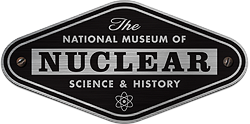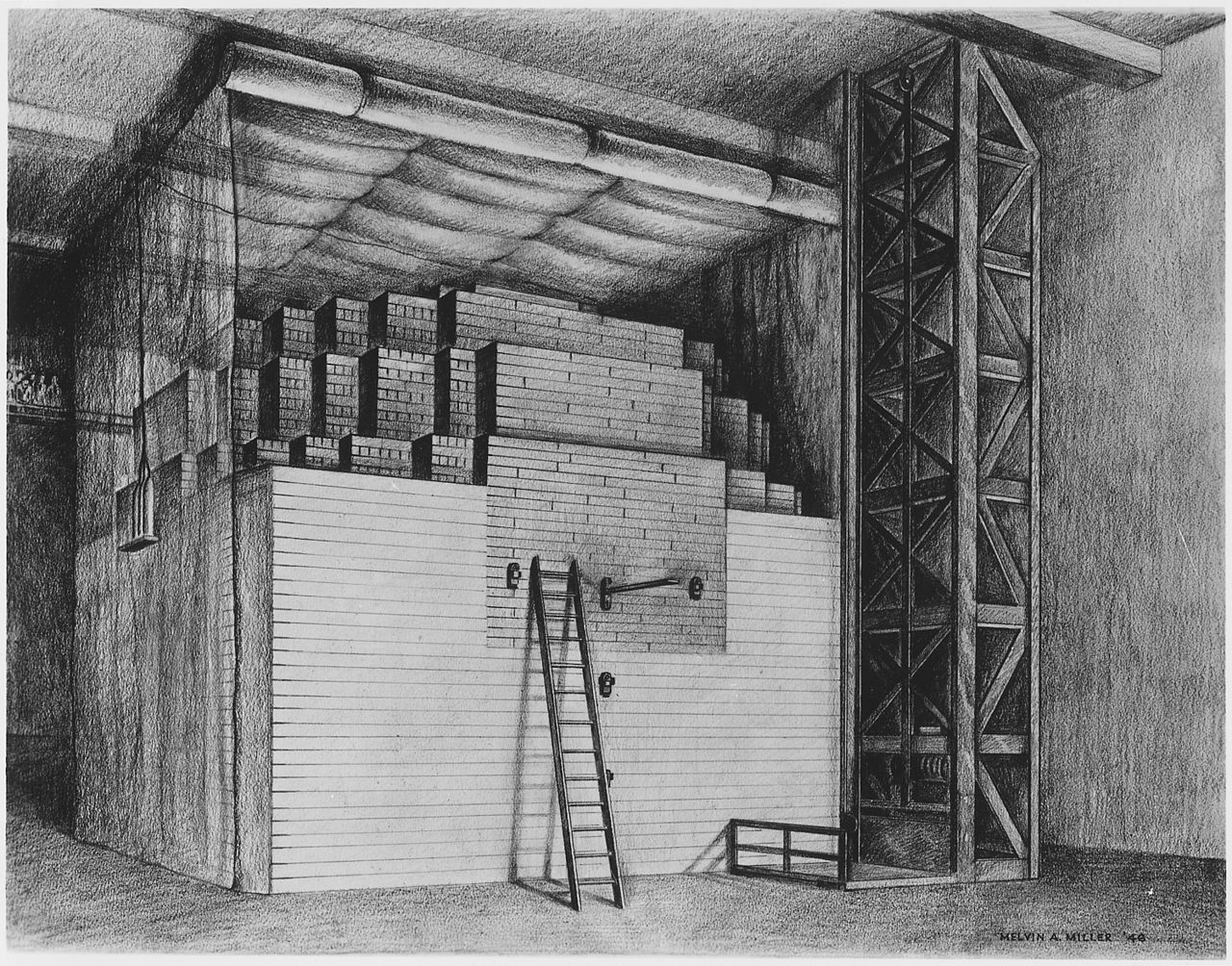December 1, 2022 Newsletter
This issue recognizes the 80th anniversary of the Chicago Pile-I. Built in a squash court at the University of Chicago, this experimental “pile” was used to demonstrate the world’s first controlled nuclear reaction on December 2, 1942.
Thanks to our many generous donors, the Atomic Heritage Foundation (AHF) and the National Museum of Nuclear Science & History (NMNS&H) are pleased to announce that the AHF’s upgraded websites will be available online by the end of December. We hope you will enjoy the new websites over the holidays!
The Manhattan Project National Historical Park is featured as the centerpiece of a new stamp series for 2023. The stamps are part of the Passport to the National Parks program.
Tickets are available to the dramatic play, Reykjavik, by Richard Rhodes from the Tonic Theater in Washington, DC. The play will be produced online beginning December 19, 2022. The play captures the historic meeting between President Ronald Reagan and Soviet Premier Mikhail Gorbachev in Reykjavik, Iceland in October 1986.
Finally, the issue highlights two new books related to the Manhattan Project. Andrew Brown’s Bound by Muscle provides fascinating biographies of two British scientists who won the Nobel Prize in 1922. It is also relates how the British collaborated with the US to use science and technology to prevail in World War II.
Vincent Kiernan’s Atomic Bill examines the career of the very ambitious science journalist William L. Laurence. General Groves gave Laurence exclusive access to the Manhattan Project in exchange for his reporting. AHF’s President Cindy Kelly recently presented an overview of the Manhattan Project at a recent book launch for Atomic Bill at The Catholic University in Washington, DC.
ATOMIC HERITAGE FOUNDATION’S WEBSITES
Thanks to dozens of generous donations, the Atomic Heritage Foundation’s newly upgraded websites will be launched in early December. Our contractor, 4Site Interactive Studios, originally built the websites. Over the past six months, 4Site has migrated over 20,000 pages and nearly 1,000 audio and video recordings to a new platform, WordPress.
This platform is stable, secure, and constantly improved. The search engine allows users to find people, places, and terms of interest across the entire content from the oral histories to “Ranger in Your Pocket” programs. The new site promises to be much easier to navigate and manage.
AHF and its partner the National Museum of Nuclear Science & History (NMNS&H, “Museum”) are so fortunate to work with 4Site’s dedicated and talented staff. When Christopher Nolan’s movie on J. Robert Oppenheimer is released in July 2023, AHF’s newly revamped websites will be ready for an influx of visitors!
80th ANNIVERSARY OF CP-1
Chicago Pile-1 or “CP-1” went critical on December 2, 1942, in a squash court under the west stands of the University of Chicago’s Stagg field. Under the direction of Nobel Prize-winning physicist Enrico Fermi, the world’s first controlled nuclear reaction took place.
Recruits from the former football team worked round the clock for two weeks arranging graphite blocks studded with smaller nuggets of uranium in 57 layers. Holes for cadmium control rods were painstakingly aligned.
Handling graphite was very dirty work. “The workers were covered in black with just red eyes shining out of their blackened faces,” Darragh Nagle recalled. “Outside, the old Gothic building was also black and gloomy. It looked like a good setting for a third-rate murder mystery.”
Arthur Holly Compton directed the Metallurgical Laboratory at the University of Chicago and remembers watching the experiment unfold. “On the balcony, a dozen scientists were watching the instruments and handling the controls…After a few preliminary tests, [Enrico] Fermi gave the order to withdraw the control rod another foot. We knew that that was going to be the real test.
“The Geiger counters registering the neutrons from the reactor began to click faster and faster, until their sound became a rattle. The reaction grew until there might be danger from the radiation up on the platform where we were standing.
“‘Throw in the safety rods,’ came Fermi’s order. And you could see the pointer move right back to zero. The rattle of the counters fell to a slow series of clicks. For the first time, atomic power had been released. It had been controlled and stopped.”
Crawford Greenewalt “remembers very well [Eugene] Wigner reaching under a desk and pulling out a bottle of Chianti in a brown paper bag and handing it to Fermi with a bow. No great excitement, no cheers, just satisfaction that the experiment had worked—’Thank God that one’s over.’”
As the observers filed from the squash court, Leo Szilard shook hands with Fermi. Knowing the world would never be the same again, Szilard said, “This day will go down as a black day in the history of mankind.” [Genius in the Shadows by William Lanouette, University of Chicago Press,1992.]
MANHATTAN PROJECT PARK STAMP
Since 1986, visitors to the national parks can collect stamps for a Passport to Your National Parks®. For 2023, ten new stamps have been issued by Eastern National for one national park and nine regional ones.
The Manhattan Project National Historical Park is honored as the national park and centerpiece for the new series. As pictured above, the national stamp features historic buildings in each of the three Park sites: B-Reactor in Hanford WA; Pond Cabin in Los Alamos, NM; and X-10 Graphite Reactor in Oak Ridge, TN.
“The national stamp provides a wonderful opportunity to showcase the park and invite people to learn about and visit the park throughout the year,” said Wendy Berhman, Acting Park Superintendent. Passport holders can collect special ink cancellations with the place and date of their visit. Passports and stamps are available at America’s National Parks and other retail sites.
The dramatic play Reykjavik by Richard Rhodes captures the weekend meeting between President Ronald Reagan and Soviet Premier Mikhail Gorbachev in Reykjavik in October 1986. The Tonic Theater is offering tickets to watch the play remotely at your convenience between December 19, 2022, to January 14, 2023.
In 1986, the US had nearly 25,000 and the USSR over 40,000 nuclear warheads to be delivered on missiles, bombers, and submarines. Both leaders were prepared to negotiate massive cuts and ultimately to eliminate their respective nuclear arsenals. However, the US’s Strategic Defense Initiative (SDI), an anti-ballistic missile system using ground and space emplacements, proved to be an intractable issue.
Addressing the press at the end, Gorbachev declared, “Despite all its drama, Reykjavik is not a failure—it’s a breakthrough. It allowed us for the first time to look over the horizon. And beyond there is a different country.”
Richard Rhodes is the author of the Pulitzer Prize-winning book The Making of the Atomic Bomb and charter Board Member of the Atomic Heritage Foundation. AHF produced a reading of an earlier version of Reykjavik with a full cast at the Carnegie Institution of Science on March 14, 2009.
BOUND BY MUSCLE BY ANDREW BROWN
Andrew Brown is a British physician who emigrated to the United States, practiced medicine in New Hampshire and North Carolina, and in recent decades became a leading biographer of scientists in the mid-20th century. The Neutron and the Bomb is a biography of Sir James Chadwick, who discovered the neutron in 1932 and led the British Mission at Los Alamos during the Manhattan Project.
Keeper of the Nuclear Conscience is a biography of Joseph Rotblat who worked at Los Alamos as part of the British Mission but was opposed to the use of nuclear weapons. In 1995, Rotblat won the Nobel Peace Prize for his leadership of the Pugwash Conferences on Science and World Peace, advocating the control and eventual elimination of nuclear weapons.
Brown’s latest biography, Bound by Muscle, focuses on two physiologists, Archibald Vivian Hill (1886-1977) and Otto Fritz Meyerhof (1884-1951). Hill and Meyerhof shared the 1922 Nobel Prize in Physiology or Medicine.
Before World War II, A.V. Hill promoted collaboration with the US on science and technology for military purposes. Many British scientists were skeptical that Americans had much to offer. On a tour of the US, Hill discovered that Americans were quite advanced, especially in radar that could be used to target aircraft and ships. Despite some reluctance on both sides, Anglo-American scientific collaboration proved to be essential to the Allied victory World War II.
ATOMIC BILL BY VINCENT KIERNAN
For over 20 years, Vincent Kiernan was a science journalist. Now Dean of the Metropolitan School of Professional Studies at Catholic University, he has just written a biography of William L. Laurence. A New York Times journalist dedicated to science reporting, Laurence was recruited by General Leslie R. Groves to witness and report on the top-secret project.
After World War II, Laurence leveraged his extraordinary role as the only reporter inside the Manhattan Project. He soon landed profitable contracts for speech making, book writing, film making, and radio broadcasting. However, Laurence became involved in a cheating scandal, plagiarizing reports, and other issues that eventually forced his retirement from the New York Times. As Kiernan relates, his ambitions outweighed his professional ethics.
HANKS FOR SUPPORTING THE WEBSITES
Thanks again to everyone who generously donated to preserving the Atomic Heritage Foundation’s websites online. The support reaffirmed the value of twenty years of effort to capture the voices of the Manhattan Project.
We are also very grateful to the National Museum of Nuclear Science & History for managing the transition of the websites with 4Site Interactive Studios. We look forward to working with the Museum as our partnership continues to strengthen and grow in 2023.





